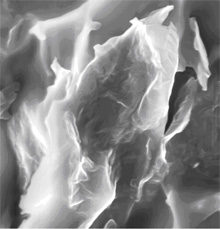Graphene-Polymer Composite
By spreading a small amount of graphene, a single-layer flat sheet of carbon atoms, throughout polymers, researchers have made tough, lightweight materials. The composites conduct electricity and can withstand much higher temperatures than the polymers alone.

Polymers can be infused with carbon nanotubes to make materials with similar properties. But graphene could be much cheaper. “You can buy [graphite] in bags for dollars a pound, while single-walled nanotubes are hundreds of dollars per gram,” says Catherine Brinson, a mechanical-engineering professor at Northwestern University, who led the work, which was published online in Nature Nanotechnology.
Graphene might also raise fewer toxicity concerns than carbon nanotubes. A separate Nature Nanotechnology study has found that long carbon nanotubes cause the same toxic reactions in mice as asbestos. The worry is that carbon nanotubes could mimic asbestos fibers, which are thin enough to penetrate into the lungs and cause cancer. Graphene, on the other hand, “is a nanometer only in thickness,” says Lawrence Drzal, director of the Composite Materials and Structures Center at Michigan State University. “They’re relatively large in two other dimensions. They won’t be able to go through blood brain barriers or into cells.”
Graphene-polymer composites would be ideal for making lightweight gasoline tanks and plastic containers that keep food fresh for weeks. They could also be used to make lighter, more fuel-efficient aircraft and car parts, as well as stronger wind turbines, medical implants, and sports equipment. What’s more, they are good electrical conductors and could be used to make transparent conductive coatings for solar cells and displays.
The advance is part of a broader research effort to make nanoparticle-embedded polymers. Carbon and glass fibers have traditionally been used to strengthen polymers– fiberglass is a common example. Unlike with fibers, though, a very small amount of nanoparticles–less than 2 percent of the composite’s volume–is enough to make the polymer stronger and heat resistant. Because less filler is used, the composite can retain the polymer’s stretchability or transparency.
Clay nanoparticles and carbon nanotubes are strong contenders for use in polymer composites. Toyota makes some engine parts from clay-nylon composites, which are stronger and can handle much higher temperatures than nylon can. Carbon-nanotube-infused polymers are used to make baseball bats and golf clubs, and they can be used in car parts such as handles and fenders–parts that are easier to paint electrostatically if they conduct electricity. But the high cost of manufacturing carbon nanotubes has limited their use.
Graphene could be a cheaper alternative. The key breakthrough needed to make the graphene-polymer hybrid was having the right kind of graphene sheets. The researchers needed one or two layers of graphene with a few hydroxyl groups or oxygen atoms dangling on the surface: these help graphene link to the polymer and disperse evenly. Researchers at Princeton University, who are coauthors of the paper, developed a way to isolate such graphene sheets from graphite oxide by expanding the material rapidly at high temperatures.
Brinson and her colleagues at Northwestern then found a way to evenly spread the graphene in the polymer. They disperse graphene in one solvent and dissolve the polymer in another. Then they mix the two until graphene is evenly dispersed throughout the polymer, and they evaporate the solvents.
“For all the properties we demonstrated, the graphene sheets perform equally or superior to nanotubes,” Brinson says. Using the same polymer, the researchers made two composites, one containing 1 percent by weight of carbon nanotubes, and the other containing the same amount of graphene. Adding graphene to the polymer made it 80 percent stiffer, while carbon nanotubes made it a little more than 50 percent stiffer. The graphene composite could withstand 30 ºC higher temperatures compared with the polymer alone, while carbon nanotubes did not increase the temperature stability.
The Northwestern material faces a tough competitor. Based on technology that Michigan State University’s Drzal developed, an East Lansing, MI, company called X G Sciences is setting up a pilot plant to manufacture various common polymers containing graphene platelets. The platelets contain stacks of about five layers of graphene, as opposed to a single sheet. Drzal, the company’s chief scientist, says that stacks will not crumple or roll up during the processing methods used to make plastic products. “It’s like when you have a single paper versus 10 sheets of paper … The stack is much stiffer and more robust.” They are also cheaper to produce, he says. “The more you get towards single sheet, the more expensive the process.”
One promising use for graphene composites will be to make fuel tanks and food packaging. Gas and liquid molecules can permeate through plain polymers, says Rodney Ruoff of the University of Texas at Austin, who was involved in the work. But graphene composites can form an impermeable barrier. That means fuel-tank linings would keep vapors in and dissipate static electricity. “You could keep sandwiches outside the refrigerator for six months without oxygen getting through and oxidizing [them],” suggests Ruoff.
Keep Reading
Most Popular
Large language models can do jaw-dropping things. But nobody knows exactly why.
And that's a problem. Figuring it out is one of the biggest scientific puzzles of our time and a crucial step towards controlling more powerful future models.
How scientists traced a mysterious covid case back to six toilets
When wastewater surveillance turns into a hunt for a single infected individual, the ethics get tricky.
The problem with plug-in hybrids? Their drivers.
Plug-in hybrids are often sold as a transition to EVs, but new data from Europe shows we’re still underestimating the emissions they produce.
Google DeepMind’s new generative model makes Super Mario–like games from scratch
Genie learns how to control games by watching hours and hours of video. It could help train next-gen robots too.
Stay connected
Get the latest updates from
MIT Technology Review
Discover special offers, top stories, upcoming events, and more.